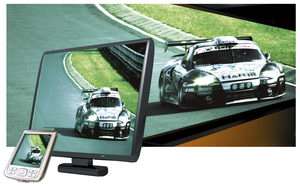Television in Top Quality

Whether you are at home or on the move new technologies are bringing TV in good quality on the “small screen”. Fraunhofer researchers will be presenting various systems at the International Broadcast Convention (IBC) in Amsterdam (September 8-12, 2006).
Crystal clear pictures and vivid colours, High Definition TV (HDTV) brings television in the highest quality into the living room. HDTV pictures are composed of pixels arranged in up to 1920 columns and 1080 rows achieving a resolution which is five times higher than conventional TV images. For comparison, the European PAL standard has a resolution of only 720 x 576 pixels.
However, high definition television is only economically viable when the data to be transmitted and stored is highly compressed. This can, for example, be achieved with MPEG-4 AVC (Advanced Video Coding), the basic principles of which were developed by the Fraunhofer Institute for Telecommunications, Heinrich-Hertz-Institut HHI. On the basis of this technology, engineers at the Fraunhofer Institute for Integrated Circuits IIS have brought about the first software-based encoder which can compress HD material in real time and in good quality – a process that was previously only possible with special hardware. A video format converter is necessary to reproduce television from the USA, which has been recorded using the American ATSC standard, on HDTV devices in Europe. This is a kind of “translator” which converts films from one standard into another with as little loss of quality as possible. To this end, researchers at the HHI have developed the HiCon multifunctional video converter. With this device, video and graphics signals can be transformed into a multitude of multimedia formats, including all of the standard digital broadcasting formats such as ATSC in America, DVB in Europe and ARIB in Japan.
Good quality sound is also an indispensable part of a perfect home-cinema evening. MPEG Surround, substantially developed by researchers at the IIS, ensures that you get authentic cinema sound in the living room. MPEG Surround combined with MPEG-4 High Efficiency Advanced Audio Coding (HE-AAC) enables a surround sound experience at 48 kbit/s. In addition, MPEG Surround is not only completely backwards compatible with mono and stereo devices, but can also be combined with the most popular broadcasting formats.
In times of increasing mobility, TV is becoming mobile as well. Digital Video Broadcasting for Handheld (DVB-H) is a new transmission method which offers multimedia reception on a mobile phone or PDA. It employs the transmission technology of digital terrestrial TV (Digital Video Broadcasting Terrestrial, DVB-T). Sharp images and good sound are ensured by the most efficient MPEG-4 audio and video encoding processes: High Efficiency Advanced Audio Coding (HE-AAC) and Advanced Video Coding (AVC). IIS engineers have developed new software components for DVB-H which are available either as stand-alone versions or as a complete media player package. The software can be used on a variety of platforms, whether Linux, Windows or Mac. A system to ensure the secure transmission of media content (ISMACryp) has also been integrated to protect the content from misuse.
DVB-H is, however, not the only technical standard for TV on mobile phones: in Asia, for example, the most widespread standard is Digital Media Broadcasting (DMB). But also Multimedia Broadcast Multicast Service (MBMS) makes TV images mobile. In the DXB project, which is being coordinated by the HHI, researchers from the HHI, the Institut für Rundfunktechnik IRT, Siemens, Sony, T-Systems and Vodafone have made a start at harmonising the different systems currently in use. Internet Protocol (IP) is at the heart of their efforts. “The result is an extension of the transmission standards of DAB, or extended DAB,” explains Dr. Ralf Schäfer from the HHI. “eDAB has a lot in common with both DVB-H and MBMS.”
Source: Fraunhofer-Gesellschaft





















